|
Displaying items by tag: watercolors
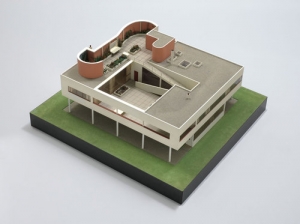
The Museum of Modern Art is busy organizing the largest exhibition on the groundbreaking architect Le Corbusier ever to be held in New York. Le Corbusier: An Atlas of Modern Landscapes is set to open on June 9 and run through September 23, 2013.
Born Charles-Édouard Jeanneret, Le Corbusier defined modern architecture during his career, which spanned five decades. Le Corbusier was not just an architect, but also an urban planner, a painter, a writer, a designer, and a theorist. Le Corbusier’s best-known buildings include the Palace for the League of Nations in Geneva, Villa Savoye in Poissy, France, the Swiss Building in Paris, and the Secretariat at the United Nations Headquarters in New York.
An Atlas of Modern Landscapes will be curated by the modern architecture scholar, Jean-Louis Cohen, and will cover Le Corbusier’s long and varied career. The exhibition will explore Le Corbusier’s contributions to architecture, interior design, and city planning. Works on view will include writings, photographs, sketches, watercolors, and models of some of Le Corbusier’s most renowned works.

When the Crystal Bridges Museum of American Art opened its doors for the first time in Bentonville, Arkansas on November 11, 2011, the institution presented about 450 works of art, nearly half of its entire holdings. A little over a year later, the Crystal Bridges’ collection has ballooned and now includes over 2,000 artworks thanks to an active acquisition program led by Executive Director Don Bacigalupi, museum curators, and a solid leadership board. Within the past year, the Crystal Bridges Museum has acquired five sculptures, eight paintings, one mixed media work, 468 prints, and 504 works on paper, including photographs, drawings, and watercolors.
Museum officials were particularly excited to acquire a large painting by Abstract Expressionist artist, Mark Rothko, titled No. 210/No.2011 (Orange) (1960) and held an official unveiling back in October. The piece, which has only been exhibited twice in public, is currently part of the museum’s temporary exhibition, See the Light: The Luminist Tradition in American Art. After the show closes in late January, the Rothko work will be moved to the museum’s Twentieth-Century Art Gallery.
Other major acquisition include a portrait by American folk artist Ammi Phillips (1788-1865), titled Woman in Black Ruffled Dress (circa 1835); a neoclassical white marble sculpture completed in 1867 by William Wetmore Story (1819-1895); a contemporary mixed-media work from the early 1980s by Californian artist Miriam Schapiro (b. 1923); and a large painting titled Tobacco Sorters (1942-44) by the twentieth-century American artist, Thomas Hart Benton (1889-1975), which was commissioned by the American Tobacco Company.
A private collector who specialized in early twentieth-century works facilitated the major growth in the museum’s print department. The recent acquisitions vary in style from Benton’s Regionalism to Charles Sheeler’s (1883-1965) Precisionism and include drypoints, etchings, engravings, lithographs, screenprints, woodcuts, and wood engravings. A selection of recently acquired prints will be part of the temporary exhibition Art Under Pressure: Early Twentieth Century American Prints, which will be on view from December 21 through April 22, 2013.
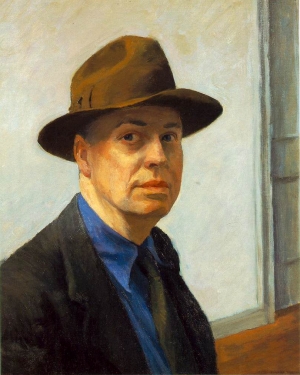
Last month the Edward Hopper House Art Center, located in the artist’s childhood home in Nyack, New York, dedicated one of its rooms to the late Reverend Arthayer R. Sanborn. A friend of the Hopper family, Sanborn led the First Baptist Church down the street from the Center and had lent the institution many works by Hopper his personal collection before his death in 2007. Sanborn also maintained the Hopper house when it fell vacant in the late 1960s.
Gail Levin, an art historian and foremost expert on Hopper, has stepped forward to object to Sanborn’s seemingly harmless recognition. Levin sent an e-mail to various news organization raising questions about how Sanborn came into his collection that included paintings, watercolors, and drawings by Hopper. Sanborn, who had eventually put more than 100 of works from his collection up for sale, claimed that Hopper and his wife, Josephine, had given many of the works to him. Levin rebutted this and said that during a conversation with Sanborn in the 1970s, he complained that Hopper had given him nothing, despite the fact that he was caring for him and his aging wife. Sanborn also claimed that he had purchased a number of works from the estate of Josephine Hopper, but under Mrs. Hopper’s will, it states that all of Hopper’s works were to go to the Whitney Museum of Art.
Officials at the Hopper House Center addressed Levin’s claims and said that the dispute was not of major concern as Sanborn has been deceased for the past five years, making her case difficult to pursue. The Center also values the Reverend’s contributions and isn’t looking to sever any ties with the Sanborn family.
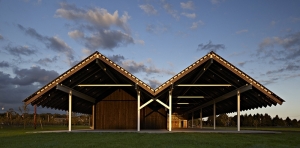
Earlier this month the Parrish Art Museum opened its new 34,400 square-foot building in Water Mill, NY to the public. Founded in 1898 by New York lawyer, Samuel Longstreth Parrish, to house his growing art collection, the museum had been a staple in Southampton, NY before moving to its new location that boasts seven sky-lit galleries and three times the exhibition space than that of the museum’s former home.
Now that the $26.2 million move is complete, the result of years of painstaking fund-raising, the Parrish hopes to become the area’s artistic epicenter. Designed by the Swiss architectural firm Herzog & Meuron in collaboration with the landscape architecture firm Reed Hilderbrand, the new Parrish building sits on 14 acres of land right off of the Montauk Highway. The building is meant to blend into the landscape and consists of connected, stretching barn-like structures that sit under a white corrugated metal roof. Large sections of glass allow the line between the natural and artificial worlds to blend.
An American art museum with about 2,600 paintings, sculptures, and works on paper in its collection, the Parrish pays extra attention to the art of the East End of Long Island. The former Southampton location was simply too small to exhibit many of the exemplary works from the museum’s permanent collection that spans from the 19th century to the present. Now, American Impressionist William Merritt Chase and the realist Fairfield Porter each have their own permanent galleries and there are three galleries just for temporary exhibitions.
Inaugurating the space is Malcolm Morley: Painting, Paper, Process, an exhibition devoted to the English-born artist known for exploring paper’s many artistic possibilities including watercolors, scale models, and freestanding sculptures. Approximately 50 works from the 1980s to present will be on view through January 13, 2013.
The Parrish’s new building also includes offices, a café, an expanded lobby, and a theater where film screenings, lectures, and performances will be held.
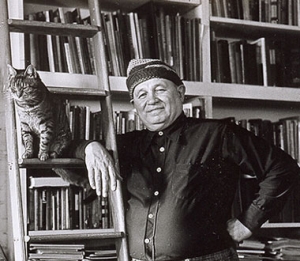
Romare Bearden: The Paper Truth opens October 24 at the 92nd Street Y’s Milton J. Weill Art Gallery in Tribeca. Featuring 44 works on paper by Romare Bearden who is best known for his expressive depictions of African-American life, the exhibition includes watercolors, collages, and mixed media pieces.
The Paper Truth wouldn’t be possible without Russell Goings, a longtime friend of Bearden. The two met in the late 1960s when Goings was the chairman of the Studio Museum in Harlem and Bearden was a member of the institution’s board. The two struck up a friendship that resulted in Goings’ impressive collection of hundreds of Bearden’s works, some that he bought from Bearden and some he received as gifts from the artist.
The exhibition includes a self-portrait that Bearden made just days before his death in 1988 at age 75. Drawn on a page from a book of Jewish mysticism, the works has never been shown publicly. Two series, The Odyssey and The Historical Figures are also part of exhibition. Bearden made several versions of The Odyssey but the 22-piece series being shown has not been displayed in its entirety in New York in over thirty years. The Historical Figures series, a small collection of portraits of people of all races who helped to shape African-American history, has never been exhibited in New York.
The exhibition, which is on loan from the collection of Russell Goings and Evelyn Boulware (Goings’ longtime companion), will be on view through December 9.
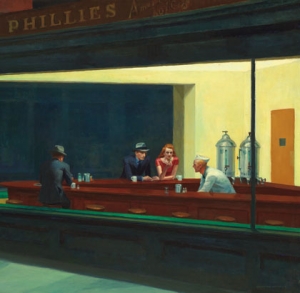
Best known for his paintings of stark diner scenes, snapshots of city life, and quiet portraits of the American landscape, there is much more to Edward Hopper’s (1882–1967) oeuvre than one might think. Referred to as a romantic, a realist, a symbolist, and even a formalist, the exhibition, Paintings by Edward Hopper (1882–1967) currently on view at the Grand Palais, Galeries Nationales in Paris aims to explore each facet of Hopper’s artistic identity.
Divided chronologically into two main parts, the first section of the exhibition covers Hopper’s early work from 1900 to 1924. During this time Hopper studied at the New York School of Art under Robert Henri, the founder of the Ashcan School of realism. Hopper also spent nearly a year in Paris in 1906, followed by shorter stays in 1909 and 1910.
The first part of the exhibition sets out to compare Hopper’s early work to that of his contemporaries as well as to the art he saw while in Paris. While in Europe, Hopper was influenced by such things as Degas’ original angles to Vermeer’s use of light. He was also moved by the soft, harmonious nature of Impressionism, which is reflected in his work from the time. This work is in sharp contrast to the almost gritty realism Hopper favored back in the United States.
1924 marked a turning point in Hopper’s career. After successful exhibitions of his watercolors of neo-Victorian houses in Gloucester, Massachusetts at the Brooklyn Museum and the Franck Rehn’s Gallery (New York), Hopper enjoyed commercial success and was able to fully devote his life to his art. Hopper’s watercolors mark the second section of the Grand Palais exhibition and feature the iconic paintings most people associate with the artist.
Curated by Didier Ottinger, assistant director of the MNAM – Center Pompidou, the exhibition of Hopper’s work will be on view through January 28, 2013.
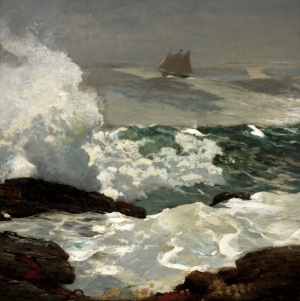
Best known for his dynamic and powerful seascapes, painter Winslow Homer (1836–1910) spent the last twenty-seven years of his life working diligently in a studio in Prout’s Neck, Maine. It was here, isolated on the craggy coast, that Winslow’s work matured and he created some of his most admired paintings. While in Maine, Homer became fascinated with the untold power of the natural world and often explored the theme in scenes of man versus nature, particularly the ocean.
Beginning September 25th, after a multi-year, $2.8 million restoration by the Portland Museum of Art, Homer’s studio will be open for public tours. After Homer’s death, the studio was passed down from family member to family member and ultimately landed in the hands of his great-grandnephew, Charles “Chip” Homer Willauer. Willauer, now 74, spent many summers living in his great-granduncle’s studio and began to worry about the future of the building. Hoping to preserve the significant piece of American art history, Willauer sold the studio to the Portland Museum of Art in 2006 for $1.8 million.
The Museum took the undertaking very seriously and went to work on renovations. The foundation was stabilized, the balcony and windows were replaced, the chimney was restored, and the exterior returned to its original green hue with brown trim. The museum ultimately raised $10.6 million to pay for the purchase and renovation of Homer’s studio as well as an endowment and educational programs and exhibitions.
To celebrate the renovation and opening, the museum will present the exhibition “Weatherbeaten: Winslow Homer and Maine,” featuring 38 oil paintings, watercolors and etchings that Homer created in his secluded studio. “Weatherbeaten” will run through December 30th.
|
|
|
|
|